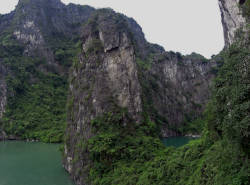Tower Karst
Cockpit Karst - Cone Karst
| en: | tower karst | cockpit karst; conical karst; kegel karst; polygonal karst |
| de: | Turmkarst (r) | Kegelkarst (r) |
| es: | karst de torres | kárst cónico (m) |
| fr: | karst (m) à tours | karst (m) à cones |
| hu: | toronykarszt | kúpkarszt |
| it: | carso (sm) a torri | carso (sm) a coni; carso (sm) poligonale |
| pt: | carste em torre | cárste cônico |
| ro: | carst (n) de turnuri | carst (n) conic |
A spectacular variety of karst landscape, dominated by steep or vertical sided limestone towers (karst towers) or cones. The towers originate as residual cones and are then steepened by water table undercutting from surrounding alluviated plains.




Tower karst, cone karst and cockpit karst are different but rather similar forms of this kind of landscape.
There are two different explanations for this kind of landscape, both explaining a certain aspect of the geology. Reality seems to be a combination of both, so we will explain both:
- Tower Karst is typically interpreted as a karst area in a very late stage of development. To explain this, we first need a sort of chronology of karst development:
- The formation of the towers is a combination of tectonic uplift and tropical karst erosion. Tectonic uplift matched by karst erosion increases tower heights, as the solution is bigger the valleys. If uplift is too slow, the towers are dissolved and shrink, if it exceeds erosional surface lowering, the towers are raised to hillside locations, and the landscape is rejuvenated to form a new generation of dolines and cone karst.
Cone and tower karst exist only in subtropic and tropic climate zones. Both typically exist in areas with tectonic uplift. In many areas, the towers are full of inactive caves at (multiple) higher levels, and with active caves through their bases. There may be alluvial plains between the towers and flat-floored depressions within them.
- Cockpit karst is the beginning of the development. After cave systems developed, grew and collapsed, the former caves form huge valleys and the limestone in between remains as hills.
- Cone karst is the more common and less spectacular form of these landscapes with limestone hills, residual cones, typically covered by rain forest.
- Tower karst is the spectacular form with 30-300 m high towers with vertical or overhanging sides. The walls are typically bare rock, as the walls are too steep for vegetation.
Tower karst occurs throughout southeast Asia. By far the most extensive and best developed tower karst is in the Guangxi Zhuang Autonomous Region of southern China. This is the ultimate development of tower karst, in which the residual hills have very steep to overhanging slopes. Other famous areas of tower karst are Vietnam, Thailand and Malaysia. Cone karst occurs in Cuba, Madagaskar and Puerto Rico.
Very common is submerged tower karst on the coast of Thailand and in the Chinese Sea. The towers form steep limestone islands in the sea, sometimes with dolines inside that form salt water lakes with steep walls. This spectacular landscape was used as a filming location for many movies. Most famous examples are:
- the James Bond movies Man with the Golden Gun
(
 imdb)
- you remember the solar panels coming out of a karst tower?
imdb)
- you remember the solar panels coming out of a karst tower?
- and Tomorrow Never Dies
(
 imdb).
imdb).
- The Beach with Leonardo DiCaprio
(
 imdb).
imdb).
Literature
- S.B. Harper (1999):
Morphology of tower karst in Krabi, southern Thailand,
Geological Society of America Abstracts with Programs, Denver, Colorado, Annual Meeting, October 25-28, 1999, p. A-52.
abstract, author, E-mail:
- Examples:
 Quang Ninh Province, Vietnam
Quang Ninh Province, Vietnam Phang-nga Province, Thailand
Phang-nga Province, Thailand Pinar del Rio, Cuba
Pinar del Rio, Cuba Northern Karst, Puerto Rico
Northern Karst, Puerto Rico
 Search DuckDuckGo for "Tower karst"
Search DuckDuckGo for "Tower karst" Tower karst - Wikipedia (visited: 03-AUG-2021)
Tower karst - Wikipedia (visited: 03-AUG-2021)
 Index
Index Topics
Topics Hierarchical
Hierarchical Countries
Countries